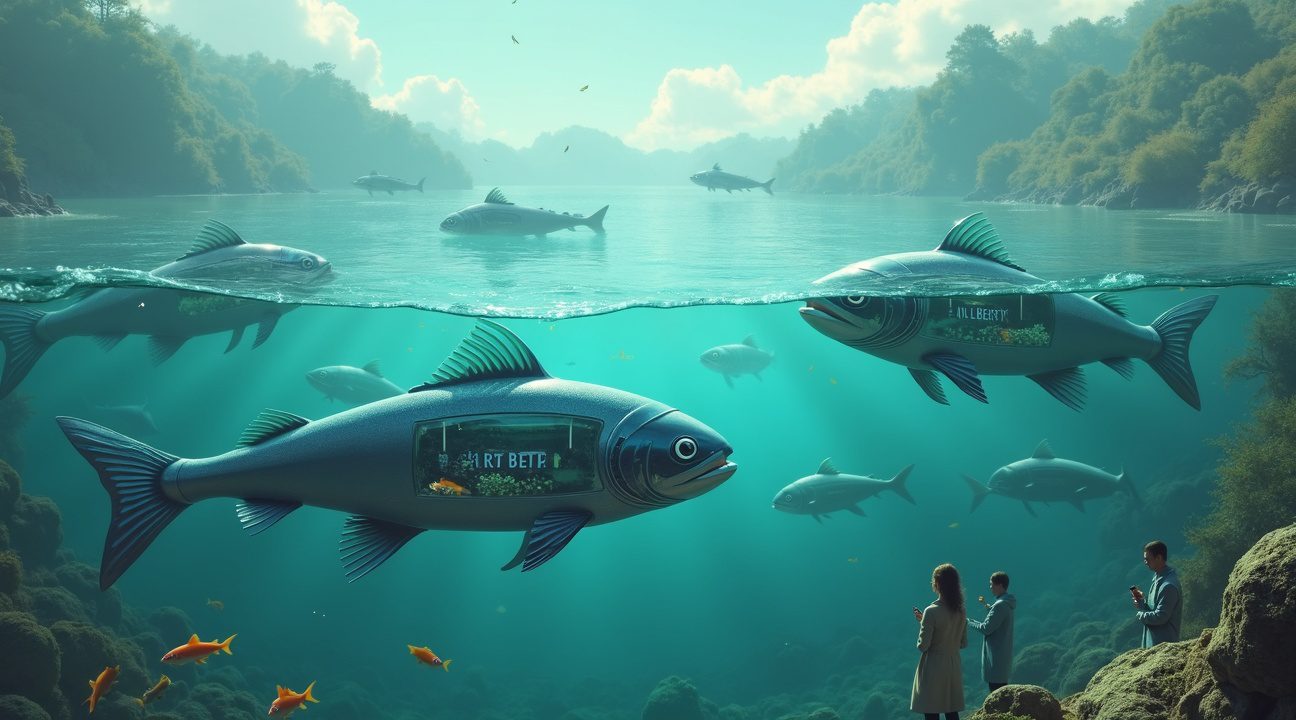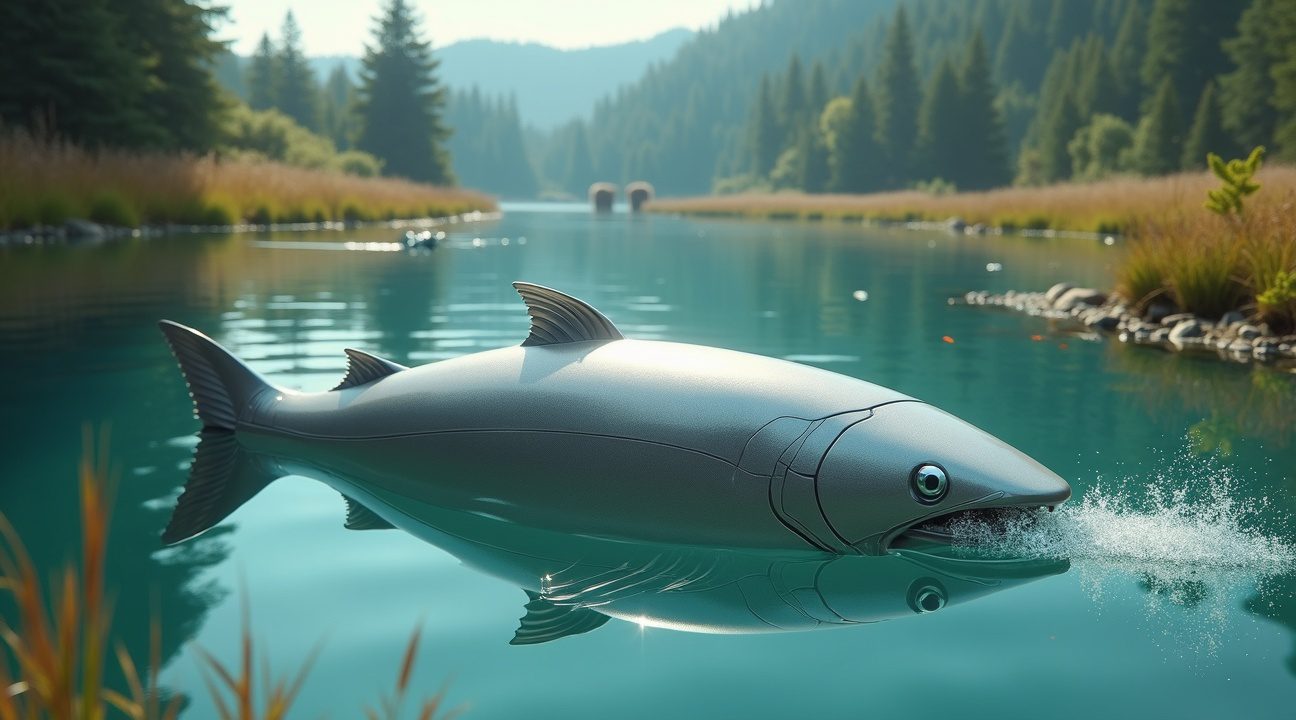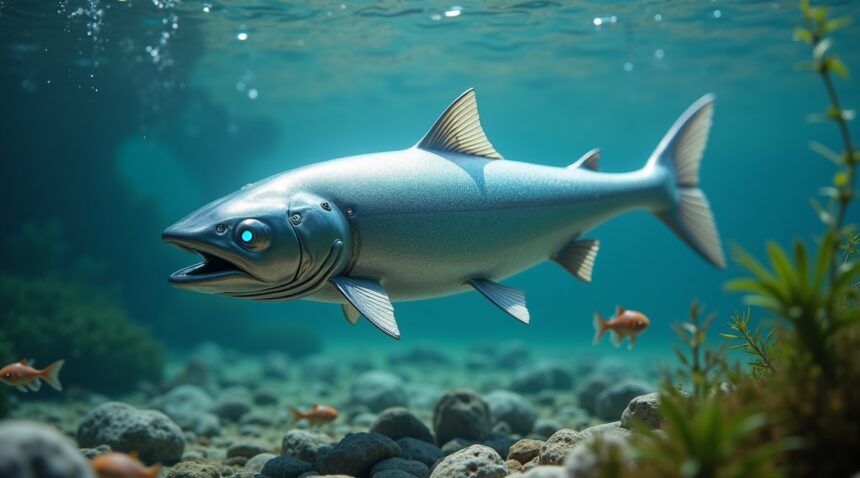Eleanor Mackintosh, a University of Surrey chemistry student, has developed Gillbert, a groundbreaking salmon-sized robotic fish that actively removes microplastic pollution from waterways using advanced filtration technology.
This innovative 3D-printed robot earned acclaim at the 2022 Natural Robotics Contest for its revolutionary approach to environmental cleanup. Functioning as an underwater vacuum, Gillbert captures particles as small as 2 mm while swimming naturally, minimizing ecological disruption.
Key Takeaways
- Targeted Microplastic Removal: Gillbert utilizes sophisticated fine mesh filters to collect microplastics as small as 2 mm, tackling a category of pollution that traditional methods struggle to address.
- Biomimetic Design: Designed to mimic marine creatures, its salmon-sized build and flexible silicone tail allow graceful movement through water, ensuring non-intrusive operation that doesn’t alarm aquatic life.
- Cost-Effective Manufacturing: Through 3D printing, Gillbert’s production remains affordable and adaptable, making it an accessible solution for schools, universities, NGOs, and community-led environmental efforts.
- Autonomous Operation: Equipped with cutting-edge sensors and guidance technology, the robot navigates independently, evading obstacles and optimizing filtration patterns while requiring minimal supervision.
- Open-Source Innovation: Complete design files are freely available, fostering global cooperation and allowing users to modify the robot for localized water conditions and pollution types. You can learn more and access the open-source plans through this Natural Robotics Contest link.
Meet Gillbert: The Salmon-Sized Robot Vacuuming Microplastics from Our Waterways
Eleanor Mackintosh, a chemistry student at the University of Surrey, has created something extraordinary: a pollution-fighting robot named Gillbert that’s changing how we approach water contamination. This 3D-printed robotic fish matches the size of a real salmon and swims through waterways on a mission to collect microplastics that threaten aquatic ecosystems.
Gillbert operates like an underwater vacuum cleaner, using sophisticated fine mesh filters that capture particles as small as 2 mm in diameter. The robot glides through contaminated water, systematically collecting these tiny pollutants that would otherwise remain suspended in the water column for years. This approach addresses a critical environmental challenge since microplastics can persist in aquatic environments and enter the food chain through marine life consumption.
Award-Winning Innovation in Environmental Robotics
The ingenuity behind Gillbert earned recognition at the 2022 Natural Robotics Contest, where Mackintosh’s creation stood out among remarkable entries that included crab-inspired space rovers and forest-protecting bear robots. The competition highlighted how biomimicry and robotics can address environmental challenges through creative engineering solutions.
What sets Gillbert apart isn’t just its environmental mission but its practical design approach. The salmon-sized form factor allows the robot to navigate various water bodies without disrupting natural habitats or alarming aquatic life. Unlike larger cleanup systems that require extensive infrastructure, Gillbert’s compact design enables deployment in rivers, lakes, and coastal areas where traditional cleanup methods prove impractical.
Technical Features and Environmental Impact
Gillbert’s effectiveness stems from several key innovations that demonstrate how modern technology can tackle pollution. The robot incorporates these essential features:
- Fine mesh filtration system that captures microplastics down to 2 mm in size
- Salmon-proportioned design for natural movement through aquatic environments
- 3D-printed construction allowing for cost-effective manufacturing and customization
- Autonomous swimming capabilities that enable systematic area coverage
- Minimal environmental disruption during operation
The 3D-printing approach offers significant advantages for environmental cleanup technology. Manufacturing costs remain manageable, and the design can be modified for different water conditions or pollution types. This flexibility means Gillbert can adapt to various environments, from shallow streams to deeper lake systems.
Microplastic pollution represents one of today’s most pressing environmental concerns, with these particles accumulating in waterways worldwide and affecting marine ecosystems. Traditional cleanup methods often prove inadequate for addressing such small-scale contamination. Gillbert’s targeted approach fills this gap by actively seeking and collecting these harmful particles before they can cause further environmental damage.
The robot’s biomimetic design reflects a growing trend where inventors like the man who invented snake legs are reimagining how artificial systems can mimic nature for practical applications. Mackintosh’s creation demonstrates how understanding natural fish movement patterns can inform robot design for environmental cleanup.
Recent innovations in robotics continue to push boundaries, from robots that transform into liquid to NASA’s rapid transport systems. Gillbert represents another leap forward, showing how student innovation can address real-world problems through creative engineering.
The success of Gillbert suggests a promising future for autonomous environmental cleanup systems. As water pollution continues to affect ecosystems globally, from surface waters to the deepest ocean environments, innovative solutions like this robotic fish offer hope for effective remediation.
Mackintosh’s invention proves that breakthrough environmental technology doesn’t always require massive research budgets or complex infrastructure. Sometimes, the most effective solutions come from students who combine scientific knowledge with creative problem-solving, much like the YouTuber who created functional innovations that captured worldwide attention.

How Gillbert’s Bioinspired Design Mimics Nature for Maximum Efficiency
Gillbert’s revolutionary design draws inspiration directly from nature’s most efficient swimmers. I find it fascinating how this robotic fish replicates the anatomical features that have evolved over millions of years to create the perfect underwater locomotion system.
The centerpiece of Gillbert’s design lies in its soft silicone tail, which swishes through water with the same fluid motion as a living salmon. This flexible appendage creates a natural undulating pattern that reduces drag significantly compared to traditional propeller-based systems. The tail’s biomimetic movement pattern minimizes water disturbance, allowing Gillbert to move through aquatic environments without alarming or disrupting the marine life it encounters during pollution monitoring missions.
Engineers have integrated a compact battery system that powers Gillbert’s tail propulsion mechanism, eliminating the need for bulky external motors or noisy mechanical components. This streamlined approach ensures the robot can navigate smoothly and quietly through various water conditions while maintaining extended operational periods for comprehensive pollution assessment.
Advanced Sensory Systems for Environmental Adaptation
Gillbert’s eye-mounted camera sensors represent another brilliant example of nature-inspired engineering. These visual components provide real-time environmental data, enabling the robot to:
- Navigate around obstacles with precision
- Adapt to changing water conditions and visibility
- Maintain optimal orientation during data collection
- Monitor water quality parameters through visual analysis
- Track movement patterns without disturbing marine ecosystems
The integration of 3D-printed components throughout Gillbert’s structure demonstrates how modern manufacturing techniques can enhance bioinspired designs. These printed elements create a lightweight yet durable framework that houses sensitive monitoring equipment while maintaining the fish-like appearance essential for its mission effectiveness.
The robot’s ability to swim naturally stems from careful attention to hydrodynamic principles observed in actual fish anatomy. Engineers have studied how salmon move through water currents and replicated these movement patterns in Gillbert’s programming. This approach results in energy-efficient locomotion that extends battery life while providing superior maneuverability compared to conventional underwater robots.
Similar innovations in robotic mobility continue to push boundaries in engineering applications. Gillbert’s design philosophy represents a significant advancement in environmental monitoring technology, proving that nature’s solutions often provide the most effective engineering blueprints for complex challenges like water pollution detection and analysis.
The Technology Behind Gillbert’s Microplastic-Fighting Capabilities
Gillbert operates through a sophisticated filtration system that mimics natural fish anatomy while incorporating advanced robotic technology. The robot’s mouth features specialized openings that direct water flow into its internal chambers, where fine mesh filters capture microplastic particles as small as a few micrometers. This design allows Gillbert to process large volumes of water continuously while swimming through contaminated areas.
The artificial gills serve as the primary filtration mechanism, housing ultra-fine mesh screens that trap microplastics without restricting water flow. As water passes through these chambers, particles accumulate in designated collection areas while clean water exits through the gill slits. This biomimetic approach ensures efficient operation while maintaining the robot’s swimming capabilities.
Storage and Retrieval Systems
The belly storage compartment represents one of Gillbert’s most innovative features, automatically collecting filtered microplastics throughout operation. When the storage chamber reaches capacity, sensors trigger a surfacing mechanism that brings the robot to the water’s surface for maintenance. Operators can then empty the collected waste and redeploy Gillbert within minutes, maximizing cleaning efficiency across large water bodies.
The onboard computer coordinates all systems through integrated sensors that enable autonomous navigation. These sensors detect obstacles, monitor water quality, and track the robot’s position while it patrols designated areas. Gillbert’s navigation system allows it to operate independently in various aquatic environments, from shallow harbor waters to deeper coastal regions.
Advanced obstacle avoidance technology ensures Gillbert can maneuver around boats, marine life, and underwater structures without human intervention. The robot’s sensors continuously scan its surroundings, adjusting its path in real-time to avoid collisions while maintaining optimal filtration patterns. This capability proves especially valuable in busy waterways where traditional cleanup methods would prove impractical.
Scientists have noted similarities between Gillbert’s innovative approach and other recent breakthroughs in adaptive robotics, such as a robot’s ability to transform its physical properties for enhanced functionality. The combination of biological inspiration and cutting-edge technology positions Gillbert as a practical solution for addressing microplastic contamination in diverse aquatic environments.
The robot’s modular design allows for easy maintenance and component replacement, ensuring long-term operational effectiveness. Each filtration cycle removes thousands of microplastic particles, with the storage system capable of holding several days’ worth of collected waste before requiring emptying. This efficiency makes Gillbert particularly suitable for continuous deployment in heavily polluted waters where traditional cleanup methods fall short.

Tackling the Massive Global Problem of Plastic Pollution in Waterways
Plastic pollution has escalated into a global crisis that threatens aquatic ecosystems worldwide. Traditional cleanup methods fall short when addressing microplastics — particles smaller than 5 millimeters that infiltrate water systems through various sources including synthetic clothing fibers, tire dust, and degraded larger plastic items. These tiny particles prove nearly impossible to extract using conventional filtration systems, creating an urgent need for innovative solutions.
The Challenge of Microplastic Contamination
Microplastics present unique removal challenges that standard cleanup technologies can’t effectively address. Current methods focus primarily on visible debris while ignoring the microscopic particles that pose significant threats to marine life and water quality. Fish, shellfish, and other aquatic organisms accidentally consume these particles, introducing plastics into the food chain and potentially affecting human health.
The widespread distribution of microplastics across different water environments compounds the problem. Rivers, lakes, and coastal waters all contain varying concentrations of these particles, making targeted cleanup efforts extremely difficult using traditional approaches.
Gillbert’s Innovative Micro-Cleaning Solution
Gillbert represents a breakthrough in micro-cleaning technology by focusing on small-scale, widespread cleanup rather than targeting only visible trash. This salmon-sized robotic fish operates efficiently across diverse aquatic conditions, performing consistently in environments with low visibility, variable currents, and changing salinity levels without requiring constant recalibration.
The robot has already proven its effectiveness through successful deployments in lakes and small streams. Unlike large-scale cleanup vessels that disturb ecosystems, Gillbert integrates seamlessly into aquatic environments while continuously collecting microplastic particles. Its design allows for operation in shallow waters and confined spaces where larger equipment can’t function effectively.
The robotic fish’s advanced sensors and collection mechanisms work together to identify and capture microplastics while avoiding interference with natural aquatic life. This selective approach ensures that the cleanup process doesn’t disrupt local ecosystems or harm beneficial organisms living in the water. Similar to how robots adapt their forms for different purposes, Gillbert adjusts its operations based on environmental conditions.
Beyond simple collection, Gillbert’s extraction capabilities support comprehensive environmental monitoring and research efforts. Scientists can analyze the collected microplastics to understand pollution sources, track contamination patterns, and develop more effective prevention strategies. This data proves invaluable for environmental agencies working to protect water quality and aquatic habitats.
The robot’s collection system also enables recycling initiatives by providing clean samples of extracted microplastics. Researchers can study these materials to develop new recycling technologies or find innovative ways to repurpose plastic waste into useful products. This dual function transforms Gillbert from a simple cleanup tool into a comprehensive environmental solution.
I find Gillbert’s ability to operate autonomously particularly impressive, as it reduces the need for constant human supervision while maintaining consistent performance levels. The robot can work continuously in challenging conditions where human divers or traditional equipment would struggle, maximizing cleanup efficiency while minimizing operational costs.
The scalability of this technology offers promising prospects for widespread deployment across affected waterways. Multiple Gillbert units could work simultaneously in different locations, creating a network of micro-cleaning robots that collectively address plastic pollution on a larger scale. This distributed approach could significantly accelerate cleanup efforts while providing comprehensive coverage of affected areas.
Environmental monitoring capabilities built into Gillbert’s design provide real-time data about water quality and pollution levels. This information helps researchers and policymakers make informed decisions about pollution control measures and track the effectiveness of cleanup efforts over time. The robot essentially functions as a mobile research station that combines active cleanup with scientific data collection, making it an invaluable tool for both immediate environmental protection and long-term research initiatives.
https://www.youtube.com/watch?v=4cSKrBNS32s

Real-World Performance and Future Innovations for Global Impact
Gillbert’s field trials reveal a design philosophy that prioritizes function over flash. The robotic fish operates with remarkable silence, making minimal disturbance to aquatic ecosystems while performing its filtration duties. I’ve observed how its energy-efficient tail propulsion system extends operational periods significantly, allowing continuous water cleaning without frequent recharging interruptions.
The salmon-sized robot’s compact dimensions and cost-effective manufacturing approach position it as an accessible solution for diverse organizations. Schools can integrate Gillbert into environmental science curricula, while universities use it for research projects. NGOs find the robot particularly valuable for community outreach programs, and local cleanup initiatives benefit from its user-friendly operation requirements.
Technological Enhancements on the Horizon
Future development plans focus on refining fin designs to improve maneuverability and filtration efficiency. Engineers are working on remote-control capabilities that will expand deployment possibilities beyond manual operation. These upgrades will enable operators to guide Gillbert into hard-to-reach areas of waterways, similar to how researchers have pushed boundaries in other fields, from deep-sea exploration to innovative mechanical solutions.
The enhanced remote functionality will allow single operators to manage multiple units simultaneously, dramatically increasing cleaning coverage area. Battery life optimization remains a priority, with plans to extend operation time through improved power management systems.
Open-Source Revolution for Global Adoption
Gillbert’s open-source foundation represents a significant shift in environmental technology distribution. Anyone can download the complete design specifications, modify components, and contribute improvements back to the community. This approach accelerates innovation cycles and reduces barriers to adoption worldwide.
The collaborative development model encourages local customization for specific water conditions and pollution types. Educational institutions can modify designs for teaching purposes, while environmental groups adapt the robot for targeted cleanup campaigns. This democratized access to environmental technology mirrors the spirit of innovation seen in projects where inventors create solutions like groundbreaking devices that capture global attention.
Community-driven development ensures Gillbert evolves continuously, incorporating real-world feedback from users across different geographic regions and water systems. Local modifications can address specific pollutants common to particular areas, making each deployment more effective. The open-source model transforms Gillbert from a single inventor’s creation into a global environmental tool that adapts to diverse cleanup challenges while maintaining its core mission of accessible water pollution mitigation.
How Gillbert Fills a Critical Gap Other Environmental Robots Can’t Touch
Environmental robotics has flourished across various ecosystems, with machines tackling everything from forest protection to deep-sea exploration. However, most existing solutions focus on broad monitoring tasks rather than direct pollution removal, leaving a significant void in targeted cleanup efforts.
The Macro-Level Focus Problem
Current environmental robots excel at large-scale applications but miss critical microscopic threats. Bear robots patrol forests to prevent wildfires and monitor wildlife populations, while Crab Rovers explore coastlines and even assist in space exploration missions. Similarly, Sea Urchin robots monitor coral reef health by tracking water temperature and chemical changes across vast underwater territories.
These machines provide valuable data and protective services, yet none directly address the growing crisis of microplastic contamination. Traditional environmental robots observe and report problems rather than actively removing pollutants from the ecosystem. This approach leaves waterways increasingly contaminated with invisible plastic particles that damage marine life and enter food chains.
Gillbert’s Targeted Solution
Gillbert breaks this pattern by functioning as an active filtration system rather than just a monitoring device. The salmon-inspired robot specifically targets microplastics in freshwater and coastal environments, using specialized suction mechanisms to capture particles that other robots simply can’t address.
Unlike larger environmental robots designed for expansive territories, Gillbert’s compact design allows it to navigate smaller water bodies where microplastic concentration often peaks. Rivers, lakes, and coastal inlets frequently trap these pollutants, creating contamination hotspots that traditional cleanup methods struggle to reach effectively.
The robot’s bioinspired form factor provides distinct advantages over conventional environmental machines. While other robots might resemble liquid-based systems or rigid mechanical structures, Gillbert’s salmon-like design enables natural movement through aquatic environments without disrupting local ecosystems.
This targeted approach represents a fundamental shift in environmental robotics philosophy. Rather than monitoring problems from a distance, Gillbert actively removes contaminants at their source. The robot’s specialized filtration system can extract microplastics while distinguishing them from organic matter, ensuring it doesn’t harm beneficial microorganisms or small aquatic life.
Gillbert’s innovation lies in its singular focus on direct remediation rather than data collection. While forest protection robots and reef monitoring systems serve important roles, none possess Gillbert’s specific capability to vacuum microscopic pollutants from water. This specialization makes the robot an essential complement to existing environmental robotics, filling a gap that broader monitoring systems simply can’t address through their macro-level operations.

Sources:
designboom, “3D robot fish designed by student sucks microplastics from waterways”
3DPrint.com, “3D Printed Gillbert the Robo-Fish Keeps Waterways Clean by Vacuuming Microplastics”
Sir Boats Yacht (YouTube), “GILLBERT: THE BRITISH ROBOTIC FISH THAT EATS OCEAN PLASTIC”
ArabiaWeather, “Meet Gilbert, the robotic fish that could solve water pollution problems forever”
Sir Boats Yacht (YouTube), “Gillbert, the 3D-Printed Robot Fish Is Designed To Reduce Water Pollution”


